List of Greek inventions and discoveries
This article is a list of major inventions and scientific and mathematical discoveries by Greek people from antiquity through the present day.
Inventions
| Technology | Date | Description | |
|---|---|---|---|
| Souvlaki | c. 17th century BC | Excavations in Santorini, Greece, unearthed sets of stone cooking supports used before the 17th century BC. In the supports there are pairs of indentations that were likely used for holding skewers. The line of holes in the base allowed the coals to be supplied with oxygen.[1] |  |
| Arch bridge | c. 1300 BC | Possibly the oldest existing arch bridge is the Mycenaean Arkadiko bridge in Greece from about 1300 BC. The stone corbel arch bridge is still used by the local populace.[2] | |
| Olympic Games | 776 BC | The ancient Olympic Games were originally a festival of the god Zeus, observed every four years in Olympia by visitors from all over Greece. Later, events such as a footrace, a javelin contest, and wrestling matches were added, evolving into a series of cut-throat athletic competitions among representatives of the various Greek city-states and one of the Panhellenic Games of ancient Greece. The first Olympics is traditionally dated to 776 BC.[3] |  |
| Geography | c. 600 BC | Building on the mapmaking practices of the Near East,[4] the philosopher Anaximander, a student of Thales, was the first known person to produce a scale map of the known world,[5] while some decades later Hecataeus of Miletus was the first to combine map-making with vivid descriptions of the people and landscapes of each location, taken from interviews with sailors and other travellers,[6] initiating a field of study which Eratosthenes later named γεωγραφία (geography).[7] |  |
| Railway | c. 600 BC | The 6 to 8.5 km long Diolkos represented a rudimentary form of railway.[8] | 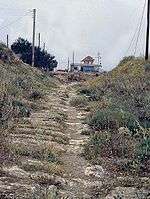 |
| Caliper | 6th century BC | Earliest example found in the Giglio wreck near the Italian coast. The wooden piece already featured one fixed and a movable jaw.[9][10] | |
| Theatre | c. 6th century BC | Theatre, in its modern sense, involving the performance of pre-written tragic, dramatic and comedic plays for an audience, first originated in Classical Athens in the 6th century BC.[11] | |
| Truss roof | 550 BC[12] | See List of Greco-Roman roofs. | 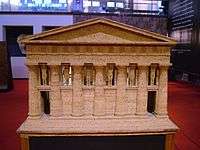 |
| Crane | c. 515 BC | Labor-saving device that allowed the employment of small and efficient work teams on construction sites. Later winches were added for heavy weights.[13] | 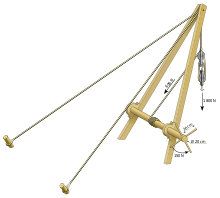 |
| Democracy | 508 BC | Led by Cleisthenes, Athenians established what is generally held as the first democracy in 508–507 BC. Cleisthenes is referred to as "the father of Athenian democracy."[14] | |
| Spiral staircase | 480–470 BC | The earliest spiral staircases appear in Temple A in Selinunte, Sicily, to both sides of the cella. The temple was constructed around 480–470 BC.[15] | 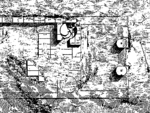 |
| Winch | 5th century BC | The earliest literary reference to a winch can be found in the account of Herodotus of Halicarnassus on the Persian Wars (Histories 7.36), where he describes how wooden winches were used to tighten the cables for a pontoon bridge across the Hellespont in 480 BC. Winches may have been employed even earlier in Assyria, though. By the 4th century BC, winch and pulley hoists were regarded by Aristotle as common for architectural use (Mech. 18; 853b10-13).[16] | |
| Shower | 4th century BC | The Ancient Greeks were the first known people to have showers, which were connected to their lead pipe plumbing system. A shower room for female athletes with plumbed-in water is depicted on an Athenian vase. A whole complex of shower-baths was also found in a 2nd-century BC gymnasium at Pergamum.[17] | 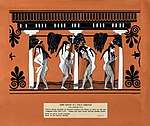 |
| Streets | c. 400 BC | Example: The Porta Rosa (4th–3rd century BC) was the main street of Elea (Italy) and connected the northern quarter to the southern quarter. The street is 5 meters wide. At its steepest, it has an inclination of 18%. It is paved with limestone blocks, griders cut in square blocks, and on one side a small gutter for the drainage of rain water. The building is dated during the time of the reorganization of the city during Hellenistic age. (4th to 3rd centuries BC) | |
| Catapult | 399BC | The historian Diodorus Siculus mentions the invention of a mechanical arrow-firing catapult (katapeltikon) by a Greek task force in 399 BC.* Campbell, Duncan (2003), Greek and Roman Artillery 399 BC – AD 363, Oxford: Osprey, p. 3, ISBN 1-84176-634-8 |  |
| Central heating | c. 350 BC | The Temple of Artemis at Ephesus was warmed by heated air that was circulated through flues laid in the floor, the first known central heating system. Central heating of buildings was later employed throughout the Greek world. | _(14742325156).jpg) |
| Lead sheathing | c. 350 BC | To protect a ship's hull from boring creatures. See Kyrenia ship. |  |
| Astrolabe | c. 300 BC | First used around 300 BC by astronomers in Greece. Used to determine the altitude of objects in the sky.[18][19] |  |
| Canal lock | early 3rd century BC | Built into Ancient Suez Canal under Ptolemy II (283–246 BC).[20][21][22] | |
| Ancient Suez Canal | early 3rd century BC | Opened by Greek engineers under Ptolemy II (283–246 BC), following earlier, probably only partly successful attempts.[23] | |
| Escapement | 3rd century BC | Described by the Greek engineer Philo of Byzantium (3rd century BC) in his technical treatise Pneumatics (chapter 31) as part of a washstand automaton for guests washing their hands. Philon's comment that "its construction is similar to that of clocks" indicates that such escapement mechanisms were already integrated in ancient water clocks.[24] | |
| Archimedes' screw | c. 3rd century BC | This device, capable of lifting solid or liquid substances from a lower plane to a higher elevation, is traditionally attributed to the Greek mathematician Archimedes of Syracuse.[25][26] | 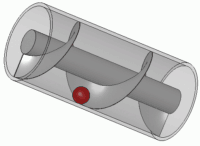 |
| Lighthouse | c. 3rd century BC | According to Homeric legend, Palamidis of Nafplio invented the first lighthouse, although they are certainly attested with the Lighthouse of Alexandria (designed and constructed by Sostratus of Cnidus) and the Colossus of Rhodes. However, Themistocles had earlier established a lighthouse at the harbor of Piraeus connected to Athens in the 5th century BC, essentially a small stone column with a fire beacon.[27] | 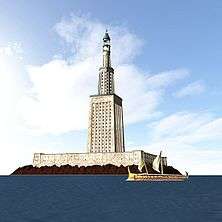 |
| Water wheel | 3rd century BC | First described by Philo of Byzantium (c. 280–220 BC).[28] | |
| Alarm clock | 3rd century BC | The Hellenistic engineer and inventor Ctesibius (fl. 285–222 BC) fitted his clepsydras with a dial and pointer for indicating the time, and added elaborate "alarm systems, which could be made to drop pebbles on a gong, or blow trumpets (by forcing bell-jars down into water and taking the compressed air through a beating reed) at pre-set times" (Vitruv 11.11).[29] | |
| Odometer | c. 3rd century BC | Odometer, a device used in the late Hellenistic time and by Romans for indicating the distance travelled by a vehicle. It was invented sometime in the 3rd century BC. Some historians attribute it to Archimedes, others to Heron of Alexandria. It helped revolutionize the building of roads and travelling by them by accurately measuring distance and being able to carefully illustrate this with a milestone. | |
| Chain drive | 3rd century BC | First described by Philo of Byzantium, the device powered a repeating crossbow, the first known of its kind.[30] | |
| Double-action principle | 3rd century BC | Universal mechanical principle that was discovered and first applied by the engineer Ctesibius in his double action piston pump, which was later developed further by Heron to a fire hose (see below).[31] | |
| Levers | c. 260 BC | First described about 260 BC by the ancient Greek mathematician Archimedes. Although used in prehistoric times, they were first put to practical use for more developed technologies in Ancient Greece.[32] | |
| Water mill | c. 250 BC | The use of water power was pioneered by the Greeks: The earliest mention of a water mill in history occurs in Philo's Pneumatics, previously been regarded as a later Arabic interpolation, but according to recent research to be of authentic Greek origin.[33][34] | |
| Three-masted ship (mizzen) | c. 240 BC | First recorded for Syracusia as well as other Syracusan (merchant) ships under Hiero II of Syracuse.[35] | |
| Gimbal | 3rd century BC | The inventor Philo of Byzantium (280–220 BC) described an eight-sided ink pot with an opening on each side, which can be turned so that any face is on top, dip in a pen and ink it-yet the ink never runs out through the holes of the side. This was done by the suspension of the inkwell at the center, which was mounted on a series of concentric metal rings which remained stationary no matter which way the pot turns itself.[36] | 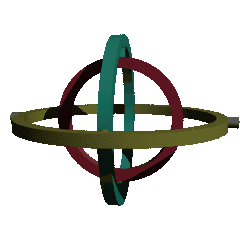 |
| Fore-and-aft rig (spritsail) | 2nd century BC | Spritsails, the earliest fore-and-aft rigs, appeared in the 2nd century BC in the Aegean Sea on small Greek craft.[37] | 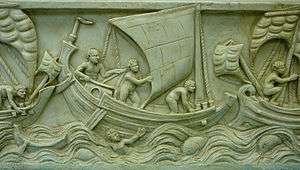 |
| Air and water pumps | c. 2nd century BC | Ctesibius and various other Greeks of Alexandria of the period developed and put to practical use various air and water pumps which served a variety of purposes,[38] such as a water organ and, by the 1st century AD, Heron's fountain. | |
| Sakia gear | 2nd century BC | First appeared in 2nd-century BC Hellenistic Egypt, where pictorial evidence already showed it fully developed.[39] | |
| Surveying tools | c. 2nd century BC | Various records relating to mentions of surveying tools have been discovered, mostly in Alexandrian sources, these greatly helped the development of the precision of Roman aqueducts. | |
| Analog computers | c. 150 BC | In 1900–1901, the Antikythera mechanism was found in the Antikythera wreck. It is thought that this device was an analog computer designed to calculate astronomical positions and was used to predict lunar and solar eclipses based on Babylonian arithmetic-progression cycles. Whereas the Antikythera mechanism is considered a proper analog computer, the astrolabe (also invented by the Greeks) may be considered as a forerunner.[40] |  |
| Differential gears | c. 100-70 BC | The Antikythera mechanism, from the Roman-era Antikythera wreck, employed a differential gear to determine the angle between the ecliptic positions of the sun and moon, and thus the phase of the moon.[41][42] |  |
| Fire hose | 1st century BC | Invented by Heron in the basis of Ctesibius' double action piston pump.[31] Allowed for more efficient fire fighting. | |
| Vending machine | 1st century BC | The first vending machine was described by Heron of Alexandria. His machine accepted a coin and then dispensed a fixed amount of holy water. When the coin was deposited, it fell upon a pan attached to a lever. The lever opened up a valve, which let some water flow out. The pan continued to tilt with the weight of the coin until it fell off, at which point a counter-weight would snap the lever back up and turn off the valve.[31] | |
| Wind vane | 50 BC | The Tower of the Winds on the Roman agora in Athens featured atop a wind vane in the form of a bronze Triton holding a rod in his outstretched hand rotating to the wind blowing. Below, its frieze was adorned with the eight wind deities. The 8 m high structure also featured sundials and a water clock inside dates from around 50 BC.[43] | |
| Clock tower | 50 BC | See Clock tower.[44] | 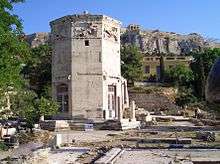 |
| Steam Engine | 1st century AD | The aeolipile is a simple bladeless radial steam turbine which spins when the central water container is heated. Torque is produced by steam jets exiting the turbine, much like a tip jet. Hero of Alexandria first described the aeolipile in the 1st century AD and many sources give him the credit for its invention.[45][46] | 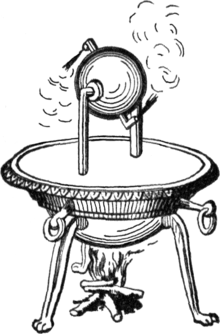 |
| Automatic doors | c. 1st century AD | Heron of Alexandria, a 1st-century AD inventor from Alexandria, Egypt, created schematics for automatic doors to be used in a temple with the aid of steam power.[31] | |
| Algebra | c. 2nd century AD | Diophantus was an Alexandrian Greek mathematician and the author of a series of books called Arithmetica. These texts deal with solving algebraic equations,[47] and have led, in number theory to the modern notion of Diophantine equation. In the context where algebra is identified with the theory of equations, Diophantus is credited as its inventor and thus the "father of algebra".[48] | |
| Pointed arch bridge | c. 5th century AD | The earliest known bridge resting on a pointed arch is the 5th or 6th century AD Karamagara Bridge in Cappadocia.[49] Its single arch of 17 m spanned an affluent of the Euphrates.[50] A Greek inscription, citing from the Bible, runs along one side of its arch rib.[51] The structure is today submerged by the Keban Reservoir.[52] | |
| Greek fire | c. 672 AD | Greek fire was an incendiary weapon used by the Eastern Roman (Byzantine) Empire that was first developed c. 672. The Byzantines typically used it in naval battles to great effect, as it could continue burning while floating on water. |  |
| Flamethrower | 7th century AD | Greek fire, heated in a brazier and pressurized by means of a pump, was ejected by an operator through a siphon in any direction against the enemy.[53] Alternatively, it could be poured down from swivel cranes or hurled in pottery grenades.[54] | .jpg) |
| Grenades | 8th century AD | Grenades appeared not long after the reign of Leo III (717–741), when Byzantine soldiers learned that Greek fire could not only be projected by flamethrowers, but also be thrown in stone and ceramic jars.[55] Larger containers were hurled by catapults or trebuchets at the enemy, either ignited before release or set alight by fire arrows after impact.[56] Grenades were later adopted for use by Muslim armies: Vessels of the characteristic spheroconical shape which many authors identify as grenade shells were found over much of the Islamic world.[57] | 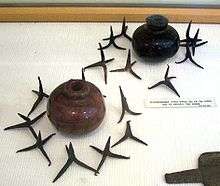 |
| Optical telegraph | c. 840 AD | In the 9th century, during the Arab–Byzantine wars, the Byzantine Empire used a system of beacons to transmit messages from the border with the Abbasid Caliphate across Asia Minor to the Byzantine capital, Constantinople.The main line of beacons stretched over some 450 miles (720 km). In the open spaces of central Asia Minor, the stations were placed over 60 miles (97 km) apart, while in Bithynia, with its more broken terrain, the intervals were reduced to ca. 35 miles (56 km). Based on modern experiments, a message could be transmitted the entire length of the line within an hour.[58] The system was reportedly devised in the reign of Emperor Theophilos (ruled 829–842) by Leo the Mathematician, and functioned through two identical water clocks placed at the two terminal stations, Loulon and the Lighthouse. Different messages were assigned to each of twelve hours, so that the lighting of a bonfire on the first beacon on a particular hour signalled a specific event and was transmitted down the line to Constantinople.[58] | |
| Hand trebuchet | 965 AD | The hand-trebuchet (cheiromangana) was a staff sling mounted on a pole using a lever mechanism to propel projectiles. Basically a portable trebuchet which could be operated by a single man, it was advocated by emperor Nikephoros II Phokas around 965 to disrupt enemy formations in the open field. It was also mentioned in the Taktika of general Nikephoros Ouranos (ca. 1000), and listed in the Anonymus De obsidione toleranda as a form of artillery.[59] | |
| Feta | c. 10th century | Feta cheese, specifically, is first recorded in the Byzantine Empire in Avicenna's Poem on Medicine under the name prósphatos (Greek: πρόσφατος, "recent" or "fresh"), and was produced by the Cretans and the Vlachs of Thessaly.[60] |  |
| Counterweight Trebuchet | 12th century AD | The earliest written record of the counterweight trebuchet, a vastly more powerful design than the simple traction trebuchet,[61] appears in the work of the 12th-century historian Niketas Choniates. Niketas describes a stone projector used by future emperor Andronikos I Komnenos at the siege of Zevgminon in 1165. This was equipped with a windlass, an apparatus required neither for the traction nor hybrid trebuchet to launch missiles. |  |
| Tsipouro | c. 14th century | The first production of tsipouro was the work of Greek Orthodox monks in the 14th century on Mount Athos in Macedonia, Greece.[62] | |
| Metaxa | 1888 | Metaxa is a Greek spirit invented by Spyros Metaxas in 1888. It is exported to over 65 countries and it is among the 100 strongest spirit brands worldwide.[63] | |
| Pap smear | 1923 | A test for cervical cancer developed by the Greek physician George Papanikolaou in 1923.[64] |  |
| Frappé coffee | 1957 | The Greek version of café frappé, using instant coffee, was invented in 1957 at the Thessaloniki International Fair.[65] | 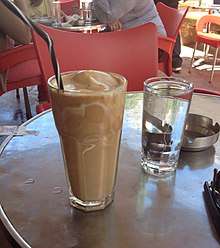 |
| Mini | 1959 | This distinctive two-door car was designed for the British Motor Corporation by Greek engineer Sir Alec Issigonis.[66] His grandfather Demosthenis migrated to Smyrna from Paros in Greece in the 1830s and through the work he did for the British-built Smyrna-Aydın Railway. | 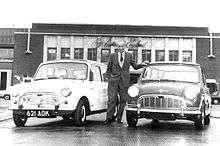 |
| Caller ID | 1968 | In 1968, Theodore Paraskevakos, while working in as a communications engineer for SITA in Athens, Greece, began developing a system to automatically identify a telephone caller to a call recipient. Developing the method for the basis for modern-day Caller ID technology. [67] | 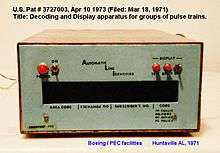 |
| Libor | 1969 | The London Inter-bank Offered Rate interest rate benchmark was devised by Greek banker Minos Zombanakis.[68][69] |  |
| BlackBerry | 1996 | Greek-Canadian businessman Mike Lazaridis founded BlackBerry, which created and manufactures the BlackBerry wireless handheld device. Lazaridis served in various positions including Co-Chairman and Co-CEO of BlackBerry from 1984 to 2012 and Board Vice Chair and Chair of the Innovation Committee from 2012 to 2013.[70] |  |
| Epi-LASIK eye surgery | 2000 | Greek ophthalmologist Ioannis Pallikaris, who was the first person to perform LASIK eye surgery in 1989,[71] developed the improved epi-LASIK technique at the University of Crete.[72] | 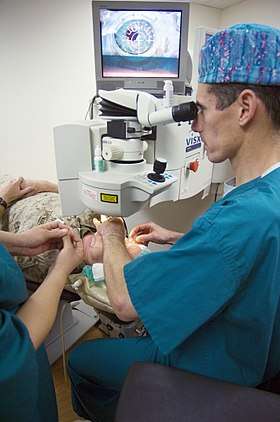 |
- Haldon, John F. (1990). Constantine Porphyrogenitus: Three treatises on imperial military expeditions. Vienna: Verlag der Österreichischen Akademie der Wissenschaften. ISBN 3700117787.
- Foss, Clive (1991). "Beacon". In Kazhdan, Alexander (ed.). The Oxford Dictionary of Byzantium. London and New York: Oxford University Press. pp. 273–274. ISBN 978-0-19-504652-6.
- Toynbee, Arnold (1973). Constantine Porphyrogenitus and His World. London and New York: Oxford University Press. ISBN 0-19-215253-X.
Discoveries
Mathematics
- Mathematical deduction - Thales of Miletus, considered by Aristotle to be the first Greek philosopher,[73] is thought to be the first individual to apply deductive reasoning to produce mathematical proofs, particularly in the field of geometry [74]
- Thales' theorem - One of the most basic theorems of geometry, stating that whenever an angle is drawn from two ends of the diameter of a circle to any third point on its circumference, the angle formed at the third point is always a perfect right angle. The phenomenon was known empirically to the Indians and Babylonians but was first proved in the 6th century BC by Thales of Miletus, making him the first known individual to whom a mathematical discovery has been attributed.[75]
- Intercept theorem - Also attributed to Thales is the fundamental theorem of geometry that states that the ratios of corresponding sides of similar triangles (i.e. triangles formed from the intersection of two common lines with two different parallel lines) are equal. Thales is said to have used his theorem to determine the height of pyramids by measuring the lengths of their shadows. [76]
- Conic sections - First developed by Menaechmus in the 4th century BC, but the most significant contribution is by Apollonius of Perga in the 3rd century BC.[77]
- Exhaustion, method of - Formalized by Eudoxus of Cnidus in the early 4th century BC, used by Archimedes to calculate the value of Pi and the area under a curve.[78]
- Proof, mathematical - The mathematical proof was a product of Greek mathematics, evolving gradually to reach the method still used today in Euclid's Elements around 300 BC.[79]
- Sieve of Eratosthenes - Developed by Eratosthenes in the 3rd century BC to calculate prime numbers.[80]
Natural Sciences
- Circumference of the Earth - The circumference of the Earth was first calculated by Eratosthenes of Cyrene in 240 BC, with an error of 1% to 15% (depending on the definition of a stadion).[81]
- Heliocentrism - The notion that the Earth and planets revolves around the Sun was first proposed by Aristarchus of Samos in the 3rd century BC.[82]
- Spherical Earth - The concept of a spherical Earth first appears in the writings of the Pythagoreans around the 6th century BC.[83]
See also
- Greek mathematics
- Greek astronomy
- Ancient Greek technology
- List of Byzantine inventions
References
- To Vima (in Greek), 6-2-2011 (picture 2 of 7)
- Hellenic Ministry of Culture: Mycenaean bridge at Kazarma Archived April 8, 2008, at the Wayback Machine
- "History". Olympic Games. Archived from the original on 9 August 2016. Retrieved 11 August 2016.
- Alex C. Purves (2010). Space and Time in Ancient Greek Narrative. Cambridge & New York: Cambridge University Press. ISBN 978-0-521-19098-5, pp 98-99.
- Timechart of historical cartography: Antiquity
- James Rennell. The geographical system of Herodotus, examined and explained, by a comparison with those of other ancient authors and with modern geography. Bulmer, 1800. p672
- Eratosthenes (2010-01-24). Eratosthenes' Geography. Translated by Roller, Duane W. Princeton University Press (published 24 January 2010). ISBN 9780691142678.
- Lewis, M. J. T. (2001) "Railways in the Greek and Roman world" Archived February 16, 2008, at the Wayback Machine, in Guy, A. / Rees, J. (eds), Early Railways. A Selection of Papers from the First International Early Railways Conference, pp. 8–19 (8 & 15), ISBN 090468508X.
- Bound, Mensun (1991) The Giglio wreck: a wreck of the Archaic period (c. 600 BC) off the Tuscan island of Giglio, Hellenic Institute of Marine Archaeology, Athens.
- Ulrich, Roger B. (2007) Roman woodworking, Yale University Press, New Haven, Conn., pp. 52f., ISBN 0-300-10341-7.
- Brown (1998, 441), Cartledge (1997, 3–5), Goldhill (1997, 54). Brown writes that ancient Greek drama "was essentially the creation of classical Athens: all the dramatists who were later regarded as classics were active at Athens in the 5th and 4th centuries BCE (the time of the Athenian democracy), and all the surviving plays date from this period" (1998, 441). "The dominant culture of Athens in the fifth century", Goldhill writes, "can be said to have invented theatre" (1997, 54).
- Hodge, A. Trevor Paul (1960) The Woodwork of Greek Roofs, Cambridge University Press, p. 41.
- Coulton, J. J. (1974), "Lifting in Early Greek Architecture", The Journal of Hellenic Studies, 94: 1–19 (7), doi:10.2307/630416, JSTOR 630416
- R. Po-chia Hsia, Lynn Hunt, Thomas R. Martin, Barbara H. Rosenwein, and Bonnie G. Smith, The Making of the West, Peoples and Cultures, A Concise History, Volume I: To 1740 (Boston and New York: Bedford/St. Martin's, 2007), 44.
- Ruggeri, Stefania : „Selinunt“, Edizioni Affinità Elettive, Messina 2006 ISBN 88-8405-079-0, p.77
- Coulton, J. J. (1974). "Lifting in Early Greek Architecture". The Journal of Hellenic Studies. 94: 1–19 (12). doi:10.2307/630416. JSTOR 630416.
- Ancient Inventions: Showers. inventions.org
- Evans, James (1998), The History and Practice of Ancient Astronomy, Oxford University Press, ISBN 0-19-509539-1, p. 155.
- Krebs, Robert E.; Krebs, Carolyn A. (2003), Groundbreaking Scientific Experiments, Inventions, and Discoveries of the Ancient World, Greenwood Press, p. 56.
- Moore, Frank Gardner (1950). "Three Canal Projects, Roman and Byzantine". American Journal of Archaeology. 54 (2): 97–111 (99–101). doi:10.2307/500198.
- Froriep, Siegfried (1986): "Ein Wasserweg in Bithynien. Bemühungen der Römer, Byzantiner und Osmanen", Antike Welt, 2nd Special Edition, pp. 39–50 (46)
- Schörner, Hadwiga (2000): "Künstliche Schiffahrtskanäle in der Antike. Der sogenannte antike Suez-Kanal", Skyllis, Vol. 3, No. 1, pp. 28–43 (33–35, 39)
- Schörner, Hadwiga (2000): "Künstliche Schiffahrtskanäle in der Antike. Der sogenannte antike Suez-Kanal", Skyllis, Vol. 3, No. 1, pp. 28–43 (29–36)
- Lewis, Michael (2000). "Theoretical Hydraulics, Automata, and Water Clocks". In Wikander, Örjan (ed.). Handbook of Ancient Water Technology. Technology and Change in History. 2. Leiden. pp. 343–369 (356f.). ISBN 90-04-11123-9.
- Oleson, John Peter (2000), "Water-Lifting", in Wikander, Örjan (ed.), Handbook of Ancient Water Technology, Technology and Change in History, 2, Leiden, pp. 217–302 (242–251), ISBN 90-04-11123-9
- David Sacks (2005) [1995]. Oswin Murray and Lisa R. Brody (eds), Encyclopedia of the Ancient Greek World. Revised Edition. New York: Facts on File. ISBN 0-8160-5722-2, pp 303-304.
- Elinor Dewire and Dolores Reyes-Pergioudakis (2010). The Lighthouses of Greece. Sarasota: Pineapple Press. ISBN 978-1-56164-452-0, pp 1-5.
- Oleson, John Peter (2000): "Water-Lifting", in: Wikander, Örjan: "Handbook of Ancient Water Technology", Technology and Change in History, Vol. 2, Brill, Leiden, ISBN 90-04-11123-9, pp. 217–302 (233)
- Landels, John G. (1979). "Water-Clocks and Time Measurement in Classical Antiquity". Endeavour. 3 (1): 32–37 [35]. doi:10.1016/0160-9327(79)90007-3.
- Werner Soedel, Vernard Foley: Ancient Catapults, Scientific American, Vol. 240, No. 3 (March 1979), p.124-125
- Jaffe, Eric (December 2006) Old World, High Tech: World's First Vending Machine. Smithsonian magazine.
- Usher, A. P. (1929). A History of Mechanical Inventions. Harvard University Press (reprinted by Dover Publications 1988). p. 94. ISBN 978-0-486-14359-0. OCLC 514178. Retrieved 7 April 2013.
- Wilson, Andrew (2002). "Machines, Power and the Ancient Economy". The Journal of Roman Studies. 92: 1–32 (7f.). doi:10.1017/s0075435800032135. JSTOR 3184857.
- Lewis, M. J. T. (1997) Millstone and Hammer: the origins of water power, University of Hull Press, pp. 1–73 especially 44–45 and 58–60, ISBN 085958657X.
- Casson, Lionel (1995): "Ships and Seamanship in the Ancient World", Johns Hopkins University Press, pp. 242, fn. 75, ISBN 978-0-8018-5130-8.
- Sarton, G. (1970) A History of Science, The Norton Library, Vol. 2., pp. 343–350, ISBN 0393005267.
- Casson, Lionel (1995): "Ships and Seamanship in the Ancient World", Johns Hopkins University Press, pp. 243–245, ISBN 978-0-8018-5130-8.
- David Sacks (2005) [1995]. Oswin Murray and Lisa R. Brody (eds), Encyclopedia of the Ancient Greek World. Revised Edition. New York: Facts on File. ISBN 0-8160-5722-2, p. 303.
- Oleson, John Peter (2000): "Water-Lifting", in: Wikander, Örjan: "Handbook of Ancient Water Technology", Technology and Change in History, Vol. 2, Brill, Leiden, pp. 217–302 (234, 270), ISBN 90-04-11123-9.
- Bernd Ulmann (2013). Analog Computing. Munich: Oldenbourg Verlag München. ISBN 978-3-486-72897-2, pp 5-6
- Wright, M. T. (2007). "The Antikythera Mechanism reconsidered" (PDF). Interdisciplinary science reviews. 32 (1). Retrieved 20 May 2014.
- Bernd Ulmann (2013). Analog Computing. Munich: Oldenbourg Verlag München. ISBN 978-3-486-72897-2, p. 6.
- Noble, Joseph V. and de Solla Price, Derek J. (1968). "The Water Clock in the Tower of the Winds" (PDF). American Journal of Archaeology. 72 (4): 345–355 (353). doi:10.2307/503828. JSTOR 503828.CS1 maint: uses authors parameter (link)
- Noble, Joseph V. and de Solla Price, Derek J. (1968). "The Water Clock in the Tower of the Winds" (PDF). American Journal of Archaeology. 72 (4): 345–355 (349). JSTOR 503828.CS1 maint: uses authors parameter (link)
- Hero (1851) [reprint of 1st century CE original], "Section 50 – The Steam Engine", written at Alexandria, Pneumatica, London: Taylor Walton and Maberly, retrieved 2009-07-03 Translated from the original Greek by Bennet Woodcroft (Professor of Machinery in University College London.
- Hero (1899). "Pneumatika, Book II, Chapter XI". Herons von Alexandria Druckwerke und Automatentheater (in Greek and German). Wilhelm Schmidt (translator). Leipzig: B.G. Teubner. pp. 228–232.
- Cajori, Florian (2010). A History of Elementary Mathematics – With Hints on Methods of Teaching. p. 34. ISBN 1-4460-2221-8.
- Boyer, Carl B. (1991). A History of Mathematics (Second ed.). Wiley. pp. 181, 230. ISBN 0-471-54397-7.
p.181:
If we think primarily of matter of notations, Diophantus has good claim to be known as the 'father of algebra', but in terms of motivation and concept, the claim is less appropriate. The Arithmetica is not a systematic exposition of the algebraic operations, or of algebraic functions or of the solution of algebraic equations.p.230:
The six cases of equations given above exhaust all possiblities for linear and quadratic equations...In this sense, then, al-Khwarizmi is entitled to be known as 'the father of algebra'p.228:
Diophantus sometimes is called the father of algebra, but this title more appropriately belongs to al-Khowarizmi... - Date: Galliazzo 1995, p. 92; O’Connor 1993, p. 129; Hild 1977, p. 145; Hellenkemper 1977–1999, pp. 730f.; Guillou 1993, p. 36; Mango 1976, p. 129; Tunç 1978, p. 108
- Galliazzo 1995, p. 92; O’Connor 1993, p. 129
- Hild 1977, p. 145
- Galliazzo 1995, p. 92
- Haldon & Byrne 1977, p. 93
- Pryor & Jeffreys 2006, pp. 378f., 609
- Forbes 1964, p. 107
- Pászthory 1986, p. 32
- Pentz 1988, pp. 89f.
- Kazhdan 1991, p. 1276.
- Chevedden 2000, p. 110
- Dalby 1996, p. 190.
- Chevedden 2000, pp. 73–76
- "Greek tsipouro". Archived from the original on 2013-08-06. Retrieved 2018-04-13.
- www.cyb.co.uk, Cyber Interactive -. "Reports • Intangible Business". www.intangiblebusiness.com. Archived from the original on 2017-02-06. Retrieved 2017-02-06.
- Diamantis A, Magiorkinis E, Androutsos G., What's in a name? Evidence that Papanicolaou, not Babes, deserves credit for the Pap test., Diagn Cytopathol. 2010 Jul;38(7):473-6. doi:10.1002/dc.21226
- 1957 International Trade Fair Archived 2006-05-02 at the Wayback Machine Greek tsipouro Archived 2013-08-06 at the Wayback Machine
- The Times higher education book review of Bardsley, Gillian. Issigonis: The Official Biography. Icon Books. ISBN 1-84046-687-1.
- https://www.bizjournals.com/baltimore/stories/2003/11/10/smallb3.html?page=all. Missing or empty
|title=(help) - "RIM co-founder donates $50M to Waterloo physics centre". CBC News. CBC News. June 5, 2008. Retrieved 8 October 2015.
- Stuart, Annie (August 2016). "A Look at LASIK Past, Present and Future (orig. publi. June 2009)". EyeNet Magazine.
- ""When Cornea Transplants Fail. What Next?"". Archived from the original on 2006-09-09. Retrieved 2018-08-08.
- Aristotle, Metaphysics Alpha, 983b18.
- (Boyer 1991, "Ionia and the Pythagoreans" p. 43)
- (Boyer 1991, "Ionia and the Pythagoreans" p. 43)
- Hieronymus (3rd century BC) about Thales: "Hieronymus says that [Thales] measured the height of the pyramids by the shadow they cast, taking the observation at the hour when our shadow is of the same length as ourselves (i.e. as our own height).". Pliny writes: "Thales discovered how to obtain the height of pyramids and all other similar objects, namely, by measuring the shadow of the object at the time when a body and its shadow are equal in length.". However Plutarch gives an account, that may suggest Thales knowing the intercept theorem or at least a special case of it:".. without trouble or the assistance of any instrument [he] merely set up a stick at the extremity of the shadow cast by the pyramid and, having thus made two triangles by the intercept of the sun's rays, ... showed that the pyramid has to the stick the same ratio which the shadow [of the pyramid] has to the shadow [of the stick]". (Source: Thales biography of the MacTutor, the (translated) original works of Plutarch and Laertius are: Moralia, The Dinner of the Seven Wise Men, 147A and Lives of Eminent Philosophers, Chapter 1. Thales, para.27)
- Boyer, C.B.; Uta Merzbach (1991), A History of Mathematics (2nd ed.), New York: Wiley, p. 145, ISBN 0-471-09763-2
- Boyer, C.B.; Uta Merzbach (1991), A History of Mathematics (2nd ed.), New York: Wiley, p. 92, ISBN 0-471-09763-2
- Boyer, C.B.; Uta Merzbach (1991), A History of Mathematics (2nd ed.), New York: Wiley, p. 104, ISBN 0-471-09763-2
- Boyer, C.B.; Uta Merzbach (1991), A History of Mathematics (2nd ed.), New York: Wiley, p. 161, ISBN 0-471-09763-2
- Van Helden, Albert (1985). Measuring the Universe: Cosmic Dimensions from Aristarchus to Halley. University of Chicago Press. pp. 4–5. ISBN 0-226-84882-5.
- C. M. Linton (12 August 2004). From Eudoxus to Einstein: A History of Mathematical Astronomy. Cambridge University Press. pp. 38–39. ISBN 978-1-139-45379-0.
- Dicks, D.R. (1970). Early Greek Astronomy to Aristotle. Ithaca, N.Y.: Cornell University Press. pp. 72–198. ISBN 978-0-8014-0561-7.